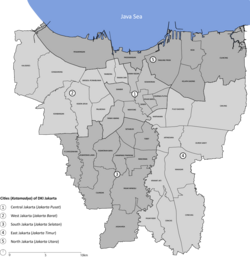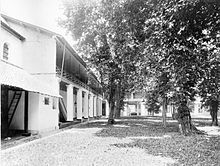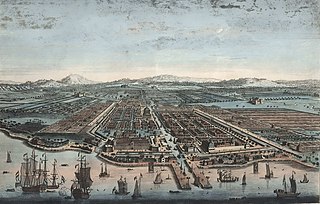
Batavia was the capital of the Dutch East Indies. The area corresponds to present-day Jakarta, Indonesia. Batavia can refer to the city proper or its suburbs and hinterland, the Ommelanden, which included the much-larger area of the Residency of Batavia in the present-day Indonesian provinces of Jakarta, Banten and West Java.

The Nederlandsch-Indische Handelsbank was a Dutch bank established in 1863 to finance trade between the Netherlands and the Dutch East Indies. During most of the colonial period, it was the second-largest of the “big three” commercial banks, behind the Netherlands Trading Company and ahead of the Nederlandsch-Indische Escompto Maatschappij, that dominated the Dutch East Indies’ financial system alongside the note-issuing Bank of Java.

The Dutch Empire or the Dutch colonial empire comprised the overseas territories and trading posts controlled and administered by Dutch chartered companies—mainly the Dutch East India Company and the Dutch West India Company—and subsequently by the Dutch Republic (1581–1795), and by the modern Kingdom of the Netherlands after 1815. It was initially a trade-based system which derived most of its influence from merchant enterprise and from Dutch control of international maritime shipping routes through strategically placed outposts, rather than from expansive territorial ventures. The Dutch were among the earliest empire-builders of Europe, following Spain and Portugal and one of the wealthiest nations of that time.

The Netherlands Indiesgulden was the unit of account of the Dutch East Indies from 1602 under the United East India Company, following Dutch practice first adopted in the 15th century. A variety of Dutch, Spanish and Asian coins were in official and common usage. After the collapse of the VOC at the end of the 18th century, control of the islands reverted to the Dutch government, which issued silver 'Netherlands Indies' gulden and fractional silver and copper coins until Indonesian independence in 1949.
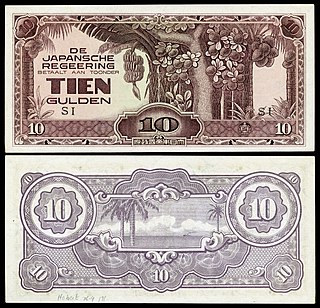
The Netherlands Indies gulden, later the Netherlands Indies roepiah, was the currency issued by the Japanese occupiers in the Dutch East Indies between 1942 and 1945. It was subdivided into 100 sen and replaced the gulden at par.

Bank Indonesia (BI) is the central bank of the Republic of Indonesia. It replaced in 1953 the Bank of Java, which had been created in 1828 to serve the financial needs of the Dutch East Indies.

Eduard Cuypers was a Dutch architect. He worked in Amsterdam and the Dutch East Indies.

Kota Tua Jakarta, officially known as Kota Tua, is a neighborhood comprising the original downtown area of Jakarta, Indonesia. It is also known as Oud Batavia, Benedenstad, or Kota Lama.

The Dutch East Indies, also known as the Netherlands East Indies, was a Dutch colony consisting of what is now Indonesia. It was formed from the nationalised trading posts of the Dutch East India Company, which came under the administration of the Dutch government in 1800.

Dutch colonial architecture refers to the various style of Dutch architecture built across the Dutch Empire. Though most of the buildings were designed by Dutch architects and dictated by Western architectural styles, even the most ardent style-purists among architects could not escape the forces of context and culture. Dutch colonial architecture often is a result of climatological adaptations or the use of local building materials - and more importantly, the rich and diverse cultural contexts. In this hybridity lies the quality of these buildings. Architecture shows that the strict racial taxonomy of a colonial system could not be maintained.

Indonesia and the Netherlands established diplomatic relations in 1949. Both countries share a special relationship, embedded in their shared history of colonial interactions for centuries. It began during the spice trade as the Netherlands established the Dutch East Indies Company (VOC) trading post in what is now Indonesia, before colonising it as the Dutch East Indies until the mid 20th century. Indonesia was the largest former Dutch colony. In the early 21st century, the Dutch government has committed to boosting its relationship with Indonesia, noting that economic, political, and interpersonal contacts should be further strengthened.

The colonial architecture of Indonesia refers to the buildings that were created across Indonesia during the Dutch colonial period, during that time, this region was known as the Dutch East Indies. These types of colonial era structures are more prevalent in Java and Sumatra, as those islands were considered more economically significant during the Dutch imperial period. As a result of this, there is a large number of well preserved colonial era buildings that are still densely concentrated within Indonesian cities in Java and Sumatra to this day.

The currency of Indonesia, the rupiah, has a long history dating back to its colonial period. Due to periods of economic uncertainty and high inflation, the currency has been re-valued several times.
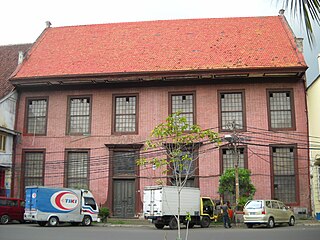
Toko Merah is a Dutch colonial landmark in Jakarta Old Town, Indonesia. Built in 1730, it is one of the oldest buildings in Jakarta. The building is located on the west side of the main canal Kali Besar. The building's red color contributes to its current name.

Mandiri Museum is the corporate museum of the namesake Bank Mandiri, located in the old banking district of Jakarta Old Town in northern Jakarta, Indonesia. The museum is housed in the former headquarters of the Netherlands Trading Society, one of the primary ancestor of ABN AMRO. The museum is closed on Mondays and public holidays. It is located next to Museum Bank Indonesia, and right in front of Jakarta Kota Station.

Bank Indonesia Museum is a bank museum located in Surabaya, Indonesia. It was officially founded by Bank Indonesia and was opened on 27 January 2012 after its restoration. The museum occupies a building formerly known as De Javasche Bank, the central bank of Dutch East Indies. After the Indonesian Independence the building continued to function as the Bank Indonesia's branch in Surabaya until 1973. The museum is closed on Monday and public holidays. It has no entrance fee.
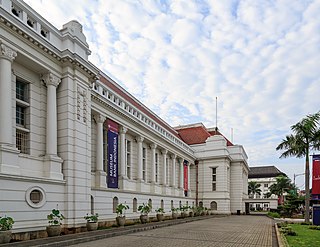
The Bank of Java was a note-issuing bank in the Dutch East Indies, founded in 1828, and nationalized in 1951 by the government of Indonesia to become the newly independent country’s central bank, later renamed Bank Indonesia. For more than a century, the Bank of Java was the central institution of the Dutch East Indies’ financial system, alongside the “big three” commercial banks. It was both a note-issuing bank and a commercial bank.

Johannes Martinus (Han) Groenewegen was a Dutch architect who was active in the Netherlands and the Dutch East Indies, and subsequently, Indonesia from the 1920s to the 1960s.
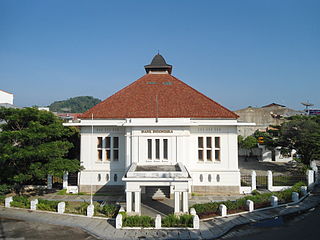
Bank Indonesia Museum of Padang is a former bank building located in Padang, Indonesia. The building was built on March 31, 1921 as the Padang branch office of De Javasche Bank before it was taken over by Bank Indonesia on July 1, 1953.

The Nederlandsch-Indische Escompto Maatschappij was a significant Dutch bank, founded in 1857 in Batavia, Dutch East Indies. In the first half of the 20th century, it was the smallest of the “big three” commercial banks, behind the Netherlands Trading Society and the Nederlandsch-Indische Handelsbank, that dominated the Dutch East Indies’ financial system alongside the note-issuing Bank of Java.

